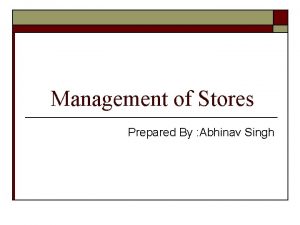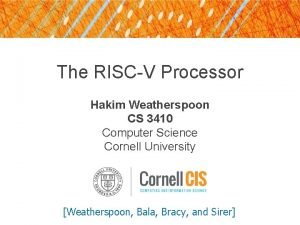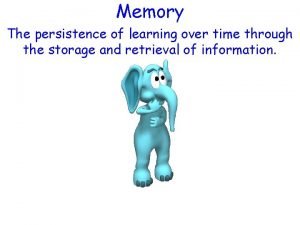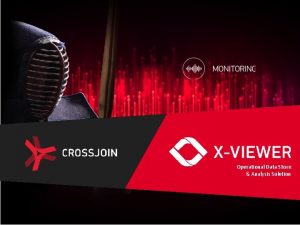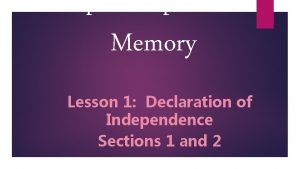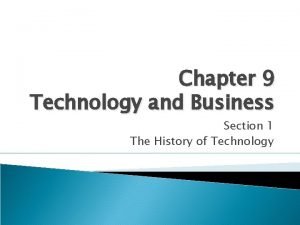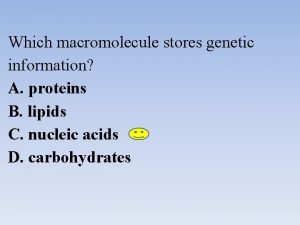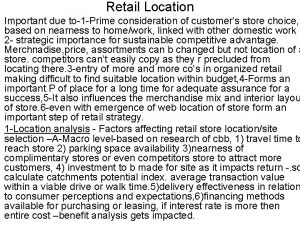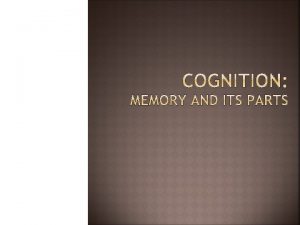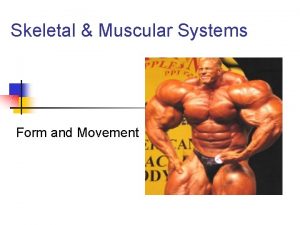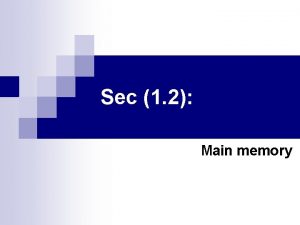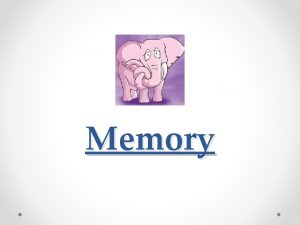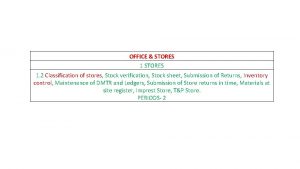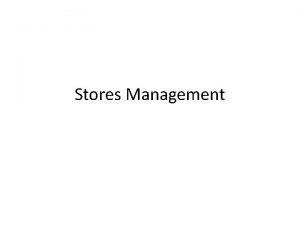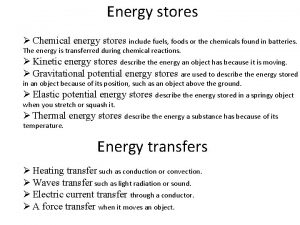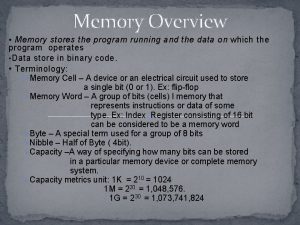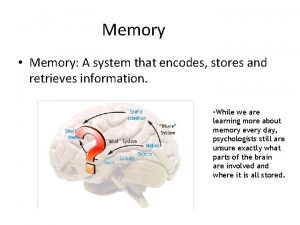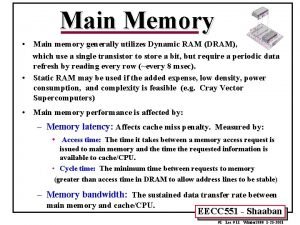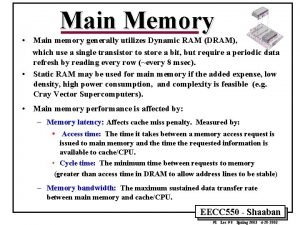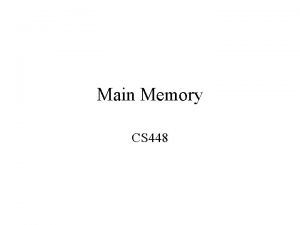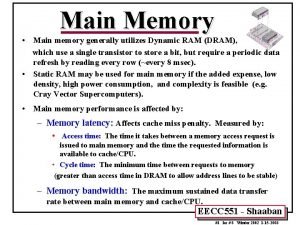1 2 Main memory Memory Stores data and



















- Slides: 19

1. 2) Main memory

Memory: • Stores data and instructions in the beginning, intermediate and final stages of the processing.

Main memory • For storing data, a computer contains a large collection of circuits, each capable of storing a single bit. • Also known as RAM “Random Access Memory” Islamic University Of Gaza, Nael Aburas 3

Memory organization • A computer main memory is organized in manageable units called cells. • Cell: A unit of main memory (typically 8 bits which is one byte) • Each cell’s size equal to eight (8) bits. • higher-order end: the left end of the row of bits on the memory • lower-order end: the right end • most significant bit: the last bit at the highorder end. • least significant bit: the bit at the right end. Islamic University Of Gaza, Nael Aburas 4

Memory organization Islamic University Of Gaza, Nael Aburas 5

Memory organization • To identify individual cell in a computer’s main memory, each cell is assigned a unique “name”, called its address. • Address: A “name” that uniquely identifies one cell in the computer’s main memory. As shown in Figure Islamic University Of Gaza, Nael Aburas 6

Measuring memory capacity • Kilobyte = 1024 byte • Megabyte = 1024 kilobyte • Gigabyte = 1024 megabyte Islamic University Of Gaza, Nael Aburas 7

Technology of memory building: There are two significant types for technologies used in memory building ( design ): 1. Magnetic core 2. Semiconductor memory

1 - Magnetic core: • Consists of million of rings, each ring in the size of pinhead, these rings connected to each other forming a mesh, electricity flows through these rings, the rings are magnetized. If the electricity flows in clock wise, the ring represents 1 but in counter clock wise it represents 0. In this kind of technology data are not lost even if the power goes off. • Note: magnetic core is non-volatile memory

Magnetic core: 1 0

2 - Semiconductor memory: • Is an integrated circuit, is put on a silicone board, each cell contains transistor which works as switch and a capacitor which keeps the charge. If the capacitor is charged, it means the value stored is 1, other wise the value is 0.

Advantages of semiconductor: • • • less bulky than the magnetic core. survive for a longer period (less damage) data can be stored in a smaller size less cost faster in information retrieval

Disadvantages of semiconductor: • it is volatile, it losses its contents as soon as the power goes off. For this purpose UPS is used

3 - Bubble memory: • It has come to take the advantages of magnetic cores and semiconductor technology

Memory contains: 1. Address register: contains the address of the data to be brought or put in the memory ( the address value is brought from the CPU ) 2. Word register: it contains the data brought or to put from/in the memory 3. LCU (local control unit): supervises all the parts of the memory 4. The memory cells ( matrix ) ( The cell size is eight bits )

Memory contains: Least significant bit ( Lower order end ) Most significant bit ( High order end ) CPU ADDRESS REGISTE R LCU MATRIX WOR D REGIS TER

Measuring Memory capacity: • • • Bit = 0 or 1 Byte = 8 bits KByte = 1024 Byte = 210 byte MByte = 1024 * 1024 Byte = 220 byte GByte = 1024 * 1024 Byte = 230 byte

Ex: given the address register of length 16 bits and the length of the word is 4 bits, computes the size of the memory in bytes Sol. : No. of address locations = 216 = 65536 No. of bits in the memory = 65536*4 = 262144 bits Size of the memory in bytes = 262144 / 8 = 32768 bytes

Types of memory: • RAM ( Random Access Memory ) – – – It is a memory where data can be read or written. It is a volatile memory It is important in putting the computer specification – DRAM ( Dynamic RAM ) or SDRAM ( Synchronous DRAM ): Is used in reference to DRAM that applies additional techniques to decrease the time needed to retrieve the contents from its memory cells ROM ( Read Only Memory ) • • • – It is only for reading, it comes from the manufacture on a chip. For example the ASCII code is store in ROM This memory is non-volatile PROM ( Programmable Read Only Memory) Can be programmed by the manufacture or by the user (can be programmed for one time only ) – EPROM (Erasable Programmable Read Only Memory ) Can be erased and reprogrammed
 Concept of store management
Concept of store management How 0x86 processor stores ox12345678 in memory?
How 0x86 processor stores ox12345678 in memory? What part of the brain stores long term memory
What part of the brain stores long term memory What part of the brain stores long term memory
What part of the brain stores long term memory Distributed data stores
Distributed data stores Operational data store architecture
Operational data store architecture Implied central idea
Implied central idea Hope despair and memory
Hope despair and memory Internal memory and external memory
Internal memory and external memory Primary memory and secondary memory
Primary memory and secondary memory Virtual memory and cache memory
Virtual memory and cache memory Dabe main daba dabe main cake
Dabe main daba dabe main cake Void main int main
Void main int main When new port shipping uses segmented marketing
When new port shipping uses segmented marketing Stores hereditary information
Stores hereditary information The most common technology staple in business today.
The most common technology staple in business today. This macromolecule stores genetic information
This macromolecule stores genetic information For service and retail stores a prime factor
For service and retail stores a prime factor Encodes stores and retrieves information
Encodes stores and retrieves information Stores minerals and anchors muscles
Stores minerals and anchors muscles
